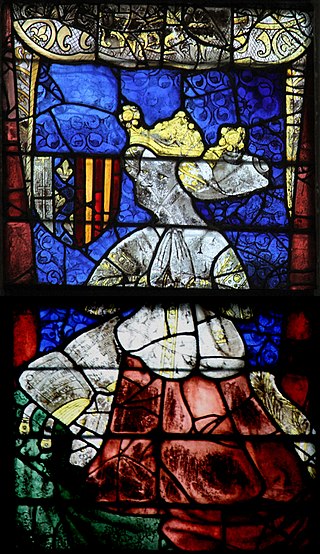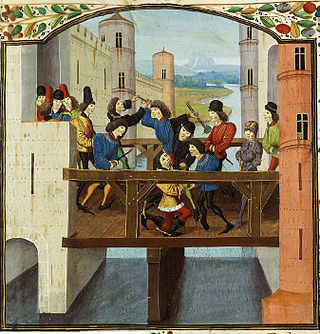| |||||
| Decades: | |||||
|---|---|---|---|---|---|
| See also: | Other events of 1466 History of France • Timeline • Years | ||||
This article relies largely or entirely on a single source .(June 2022) |
Events from the year 1466 in France
| |||||
| Decades: | |||||
|---|---|---|---|---|---|
| See also: | Other events of 1466 History of France • Timeline • Years | ||||
This article relies largely or entirely on a single source .(June 2022) |
Events from the year 1466 in France

Louis XI, called "Louis the Prudent", was King of France from 1461 to 1483. He succeeded his father, Charles VII. Louis entered into open rebellion against his father in a short-lived revolt known as the Praguerie in 1440. The king forgave his rebellious vassals, including Louis, to whom he entrusted the management of the Dauphiné, then a province in southeastern France. Louis's ceaseless intrigues, however, led his father to banish him from court. From the Dauphiné, Louis led his own political establishment and married Charlotte of Savoy, daughter of Louis, Duke of Savoy, against the will of his father. Charles VII sent an army to compel his son to his will, but Louis fled to Burgundy, where he was hosted by Philip the Good, the Duke of Burgundy, Charles' greatest enemy.

Charles VI, nicknamed the Beloved and later the Mad, was King of France from 1380 until his death in 1422. He is known for his mental illness and psychotic episodes that plagued him throughout his life.

Jean Balue was a French cardinal and minister of Louis XI. Born without resources, he managed to climb the political ladder by exploiting connections, to whom he often did not remain loyal, and by making himself an indispensable agent of the king's purposes in a time of political disorder in France. His services were as much military as ecclesiastical, bringing him the critical task of defending the city of Paris against the King's enemies. His work as a diplomat in dealing with Duke Francis of Brittany and with Charles de France brought him the office of first minister to the King. Balue overreached himself in negotiating a treaty between the King and Charles the Bold, who had become Duke of Burgundy and was trying to recover all his family inheritance. Secret correspondence revealed that he might have been playing both sides in the negotiation, and he was arrested, and held on charges of treason from 1469 to 1481, while King and Pope argued over jurisdiction. After the death of King Louis and Pope Sixtus, the new French king, Charles VIII, appointed Balue his ambassador in Rome.

Charles I, nicknamed the Bold, was Duke of Burgundy from 1467 to 1477.

Marie Anne de La Trémoille, princesse des Ursins, was a French courtier and royal favourite known for her political influence, being a de facto ruler of Spain from 1701 until 1714. She spent most of her life as an agent of French influence abroad, at first in Rome, and then in Spain under the new Bourbon dynasty, followed by a final period at the exiled Stuart court in Rome. She played a central role in the Spanish royal court during the first years of the reign of Philip V, until she was ousted from the country following a power struggle with the new queen consort, Elisabeth Farnese.

Charles of Blois-Châtillon, nicknamed "the Saint", was the legalist Duke of Brittany from 1341 until his death, via his marriage to Joan, Duchess of Brittany and Countess of Penthièvre, holding the title against the claims of John of Montfort. The cause of his possible canonization was the subject of a good deal of political maneuvering on the part of his cousin, Charles V of France, who endorsed it, and his rival, Montfort, who opposed it. The cause fell dormant after Pope Gregory XI left Avignon in 1376, but was revived in 1894. Charles of Blois was beatified in 1904.

Francis II was Duke of Brittany from 1458 to his death. He was the grandson of John IV, Duke of Brittany. A recurring theme in Francis' life would be his quest to maintain the quasi-independence of Brittany from France. As such, his reign was characterized by conflicts with King Louis XI of France and with his daughter, Anne of France, who served as regent during the minority of her brother, King Charles VIII. The armed and unarmed conflicts from 1465 to 1477 and 1484–1488 have been called the "War of the Public Weal" and the Mad War, respectively.

JeanFouquet was a French painter and miniaturist. A master of panel painting and manuscript illumination, and the apparent inventor of the portrait miniature, he is considered one of the most important painters from the period between the late Gothic and early Renaissance. He was the first French artist to travel to Italy and experience first-hand the early Italian Renaissance.

Yolande of Aragon was Duchess of Anjou and Countess of Provence by marriage, who acted as regent of Provence during the minority of her son. Yolande played a crucial role in the struggles between France and England, influencing events such as the financing of Joan of Arc's army in 1429 that helped tip the balance in favour of the French. She was also known as Yolanda de Aragón and Violant d'Aragó. Tradition holds that she commissioned the famous Rohan Hours.

Margaret of Nevers, also known as Margaret of Burgundy, was Dauphine of France and Duchess of Guyenne as the daughter-in-law of King Charles VI of France. A pawn in the dynastic struggles between her family and in-laws during the Hundred Years' War, Margaret was regarded as the future Queen of France at two separate times, as a result of her two marriages: first to the Dauphin and second to the Duke of Brittany.

The War of the Public Weal was a conflict between the king of France and an alliance of feudal nobles, organized in 1465 in defiance of the centralized authority of King Louis XI of France. It was masterminded by Charles the Bold, Count of Charolais, son of the Duke of Burgundy, with the king's brother Charles, Duke of Berry, as a figurehead. The rebels succeeded in attaining concessions from the crown after several months of fighting, though conflict would break out again between the league and the crown in the Mad War of 1485 in a decisive victory for the crown.

Jean (II) Juvénal des Ursins (1388–1473), the son of the royal jurist and provost of the merchants of Paris Jean Juvénal, was a French cleric and historian. He is the author of several legal treatises and clerical publications and the Histoire de Charles VI, Roy de France is attributed to him. His works serve as some of the main sources for information relating to the Armagnac-Burgundian Civil War and the final phase of the Hundred Years' War.

Tanneguy III du Châtel was a Breton knight who fought in the Armagnac–Burgundian Civil War and the Hundred Years' War. A member of the Armagnac party, he became a leading adviser of King Charles VII of France, and was one of the murderers of Duke John the Fearless of Burgundy in 1419.

The Bal des Ardents or the Bal des Sauvages, was a masquerade ball held on 28 January 1393 in Paris at which Charles VI of France performed in a dance with five members of the French nobility. Four of the dancers were killed in a fire caused by a torch brought in by Charles's brother Louis I, Duke of Orléans.

Louis-Auguste Juvénal des Ursins d'Harville, Count of Harville was a French military officer and politician in late 18th-century France. A Divisional General in the French Revolutionary Wars and the Napoleonic Wars, he was present at the Battle of Jemappes on 6 November 1792 and led the Reserve Division at the subsequent Siege of Namur.

The Wars of Liège were a series of three rebellions by the Prince-Bishopric of Liège, in the town of Liège in modern-day Belgium, against the expanding Burgundian State between 1465 and 1468. On each occasion, the rebels were defeated by Burgundian forces commanded by Charles the Bold and the city was twice burned to the ground.
Events from the year 1470 in France
John II, called Jean de L'Aigle, was Count of Penthièvre from 1433 until his death. He was also Count of Périgord from 1437.
Olivier was Count of Penthièvre and Lord of Avesnes from 1404 until his death.
Events from the year 1473 in France.